ВУЗ: Не указан
Категория: Не указан
Дисциплина: Не указана
Добавлен: 01.04.2021
Просмотров: 1557
Скачиваний: 7
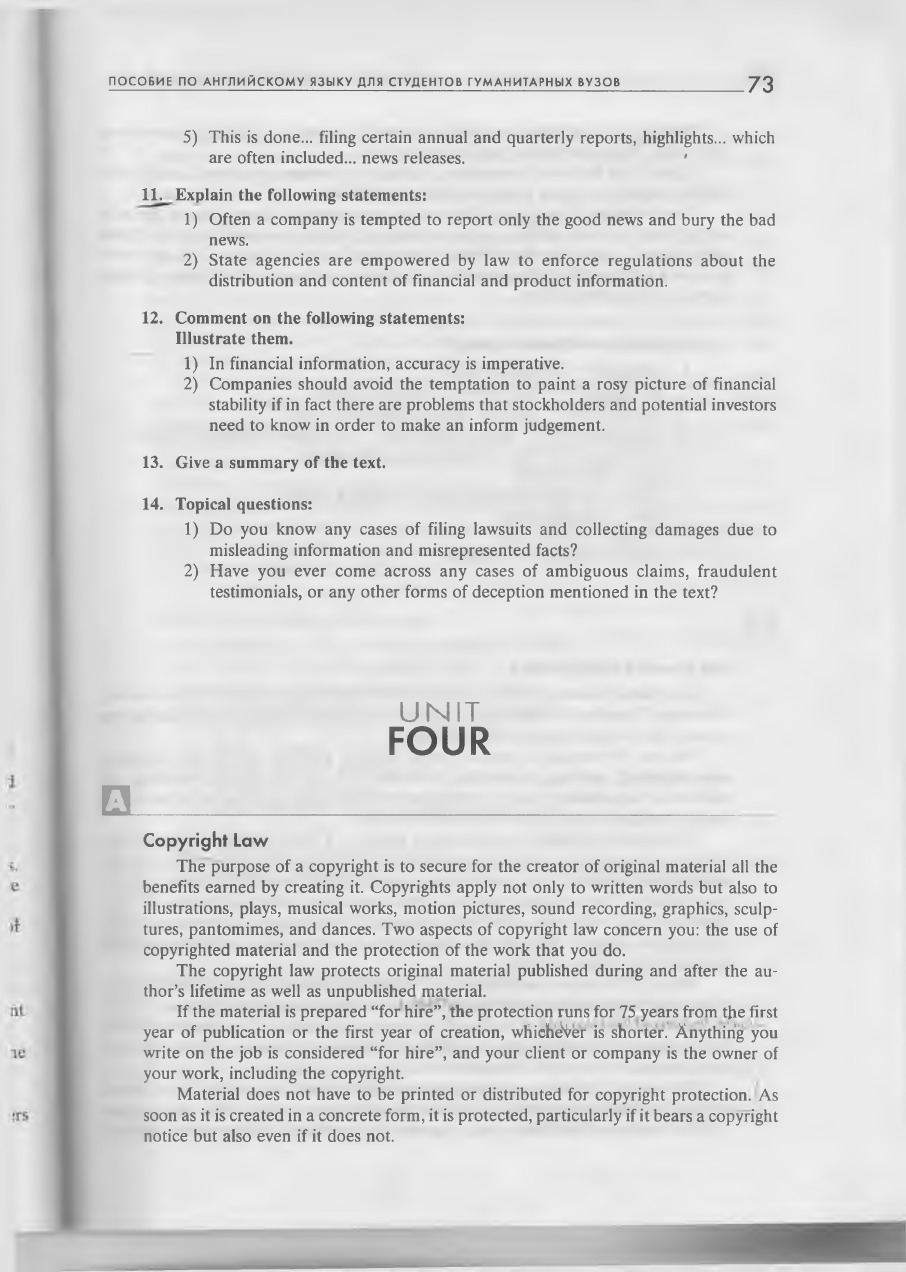
П О С О Б И Е П О А Н Г Л И Й С К О М У Я З Ы К У Д Л Я С Т У Д Е Н Т О В Г У М А Н И Т А Р Н Ы Х В У З О В
73
5) This is done... filing certain annual and quarterly reports, highlights... which
are often included... news releases.
'
11. Explain the following statements:
1) Often a company is tempted to report only the good news and bury the bad
news.
2) State agencies are empowered by law to enforce regulations about the
distribution and content of financial and product information.
12. Comment on the following statements:
Illustrate them.
1) In financial information, accuracy is imperative.
2) Companies should avoid the temptation to paint a rosy picture of financial
stability if in fact there are problems that stockholders and potential investors
need to know in order to make an inform judgement.
13. Give a summary of the text.
14. Topical questions:
1) Do you know any cases of filing lawsuits and collecting damages due to
misleading information and misrepresented facts?
2) Have you ever come across any cases of ambiguous claims, fraudulent
testimonials, or any other forms of deception mentioned in the text?
U N I T
FOUR
□
Copyright Law
The purpose of a copyright is to secure for the creator of original material all the
benefits earned by creating it. Copyrights apply not only to written words but also to
illustrations, plays, musical works, motion pictures, sound recording, graphics, sculp
tures, pantomimes, and dances. Two aspects of copyright law concern you: the use of
copyrighted material and the protection of the work that you do.
The copyright law protects original material published during and after the au
thor’s lifetime as well as unpublished material.
If the material is prepared “for hire”, the protection runs for 75 years from the first
year of publication or the first year of creation, whichever is shorter. Anything you
write on the job is considered “for hire”, and your client or company is the owner of
your work, including the copyright.
Material does not have to be printed or distributed for copyright protection. As
soon as it is created in a concrete form, it is protected, particularly if it bears a copyright
notice but also even if it does not.
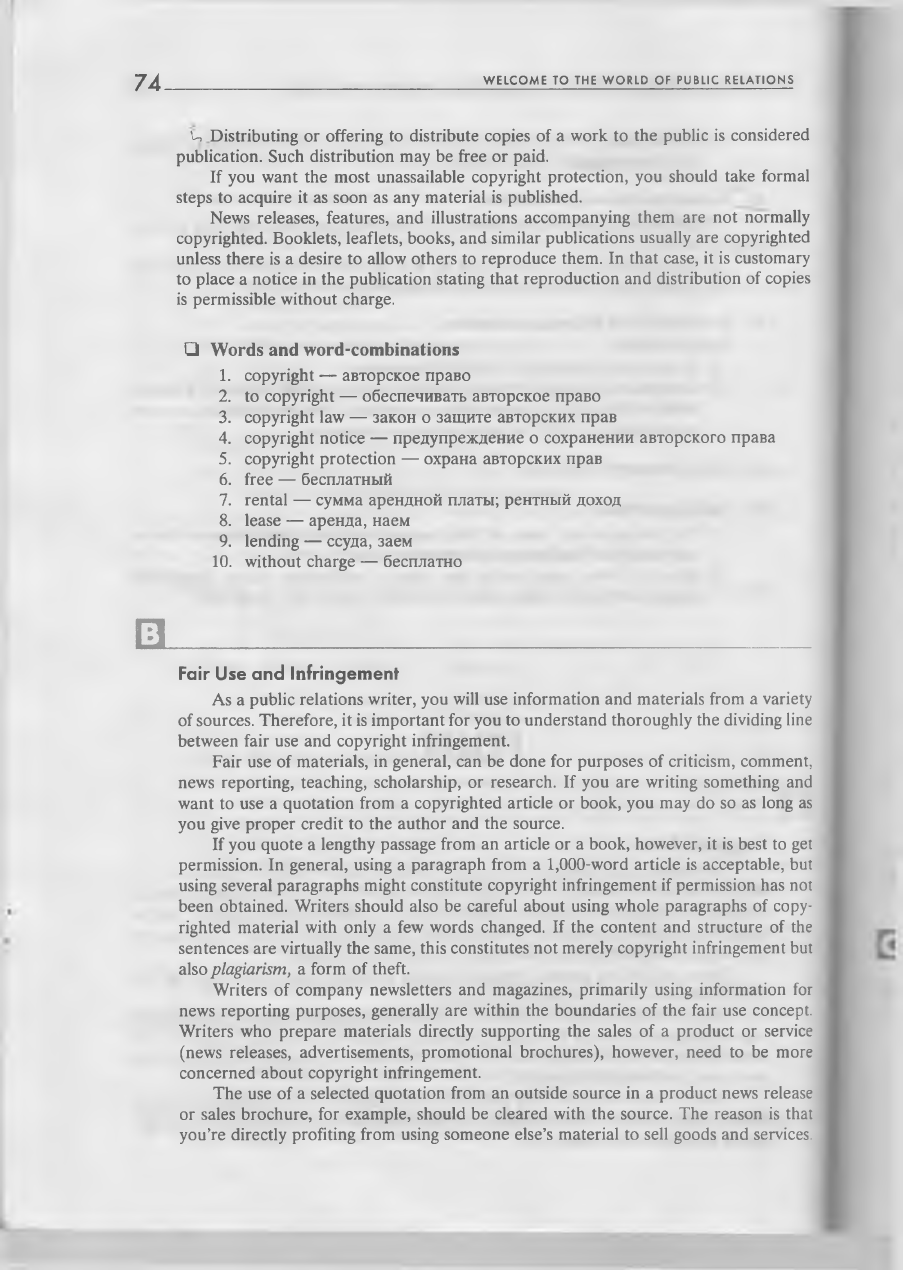
74
W E L C O M E T O T H E W O R L D O F P U B L I C R E L A T I O N S
U
Distributing or offering to distribute copies of a work to the public is considered
publication. Such distribution may be free or paid.
If you want the most unassailable copyright protection, you should take formal
steps to acquire it as soon as any material is published.
News releases, features, and illustrations accompanying them are not normally
copyrighted. Booklets, leaflets, books, and similar publications usually are copyrighted
unless there is a desire to allow others to reproduce them. In that case, it is customary
to place a notice in the publication stating that reproduction and distribution of copies
is permissible without charge.
□ Words and word-combinations
1. copyright — авторское право
2. to copyright — обеспечивать авторское право
3. copyright law — закон о защите авторских прав
4. copyright notice — предупреждение о сохранении авторского права
5. copyright protection — охрана авторских прав
6. free — бесплатный
7. rental — сумма арендной платы; рентный доход
8. lease — аренда, наем
9. lending — ссуда, заем
10. without charge — бесплатно
0
______________________________________________
Fair Use and Infringement
As a public relations writer, you will use information and materials from a variety
of sources. Therefore, it is important for you to understand thoroughly the dividing line
between fair use and copyright infringement.
Fair use of materials, in general, can be done for purposes of criticism, comment,
news reporting, teaching, scholarship, or research. If you are writing something and
want to use a quotation from a copyrighted article or book, you may do so as long as
you give proper credit to the author and the source.
If you quote a lengthy passage from an article or a book, however, it is best to get
permission. In general, using a paragraph from a 1,000-word article is acceptable, but
using several paragraphs might constitute copyright infringement if permission has not
been obtained. Writers should also be careful about using whole paragraphs of copy
righted material with only a few words changed. If the content and structure of the
sentences are virtually the same, this constitutes not merely copyright infringement but
also
plagiarism,
a form of theft.
Writers of company newsletters and magazines, primarily using information for
news reporting purposes, generally are within the boundaries of the fair use concept.
Writers who prepare materials directly supporting the sales of a product or service
(news releases, advertisements, promotional brochures), however, need to be more
concerned about copyright infringement.
The use of a selected quotation from an outside source in a product news release
or sales brochure, for example, should be cleared with the source. The reason is that
you’re directly profiting from using someone else’s material to sell goods and services.
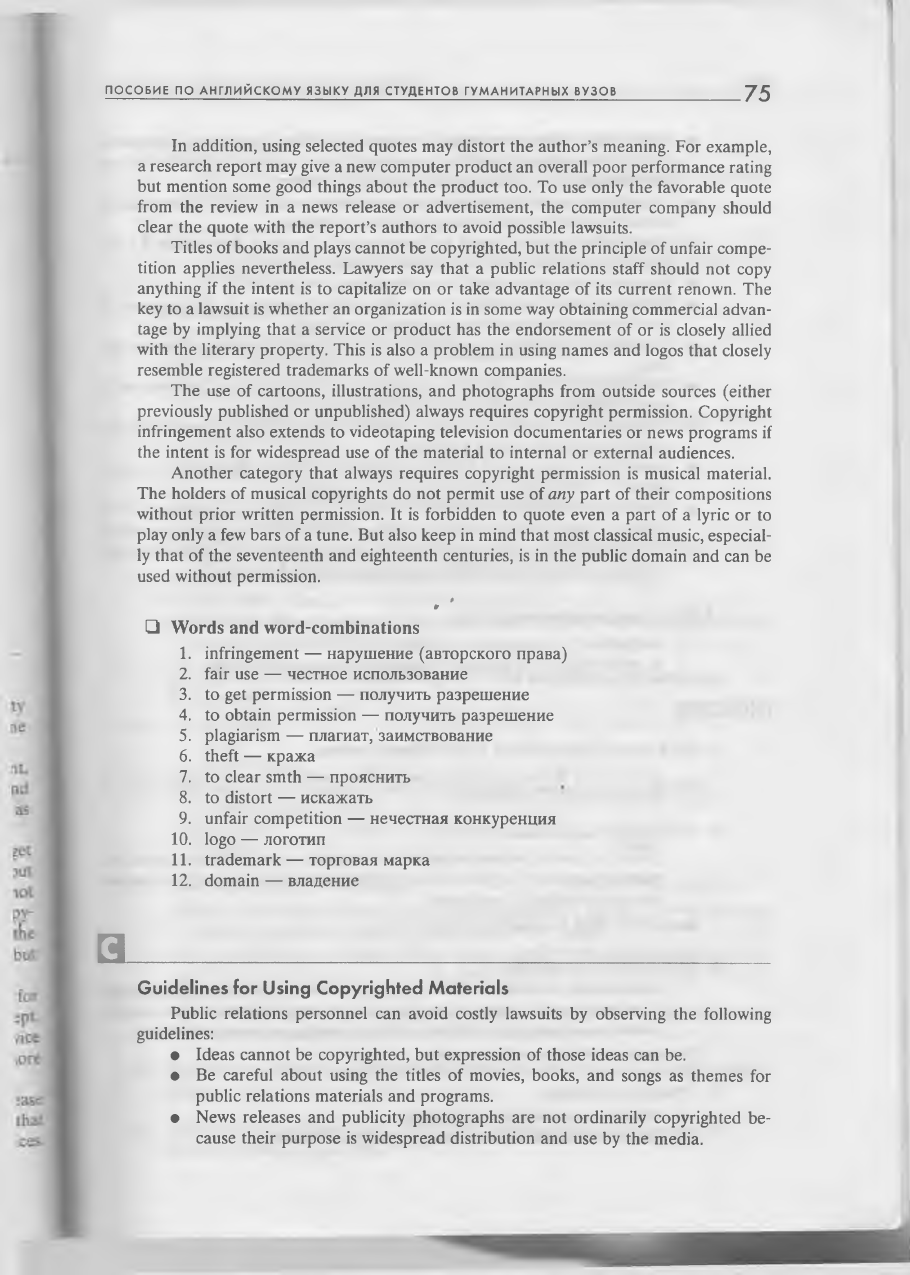
П О С О Б И Е П О А Н Г Л И Й С К О М У Я З Ы К У Д Л Я С Т У Д Е Н Т О В Г У М А Н И Т А Р Н Ы Х В У З О В
75
In addition, using selected quotes may distort the author’s meaning. For example,
a research report may give a new computer product an overall poor performance rating
but mention some good things about the product too. To use only the favorable quote
from the review in a news release or advertisement, the computer company should
clear the quote with the report’s authors to avoid possible lawsuits.
Titles of books and plays cannot be copyrighted, but the principle of unfair compe
tition applies nevertheless. Lawyers say that a public relations staff should not copy
anything if the intent is to capitalize on or take advantage of its current renown. The
key to a lawsuit is whether an organization is in some way obtaining commercial advan
tage by implying that a service or product has the endorsement of or is closely allied
with the literary property. This is also a problem in using names and logos that closely
resemble registered trademarks of well-known companies.
The use of cartoons, illustrations, and photographs from outside sources (either
previously published or unpublished) always requires copyright permission. Copyright
infringement also extends to videotaping television documentaries or news programs if
the intent is for widespread use of the material to internal or external audiences.
Another category that always requires copyright permission is musical material.
The holders of musical copyrights do not permit use of
any
part of their compositions
without prior written permission. It is forbidden to quote even a part of a lyric or to
play only a few bars of a tune. But also keep in mind that most classical music, especial
ly that of the seventeenth and eighteenth centuries, is in the public domain and can be
used without permission.
#
*
□ Words and word-combinations
1. infringement — нарушение (авторского права)
2. fair use — честное использование
3. to get permission — получить разрешение
4. to obtain permission — получить разрешение
5. plagiarism — плагиат, заимствование
6. theft — кража
7. to clear smth — прояснить
8. to distort — искажать
9. unfair competition — нечестная конкуренция
10. logo — логотип
11. trademark — торговая марка
12. domain — владение
H _ ________________________________________________________________________________
Guidelines for Using Copyrighted Materials
Public relations personnel can avoid costly lawsuits by observing the following
guidelines:
• Ideas cannot be copyrighted, but expression of those ideas can be.
• Be careful about using the titles of movies, books, and songs as themes for
public relations materials and programs.
• News releases and publicity photographs are not ordinarily copyrighted be
cause their purpose is widespread distribution and use by the media.
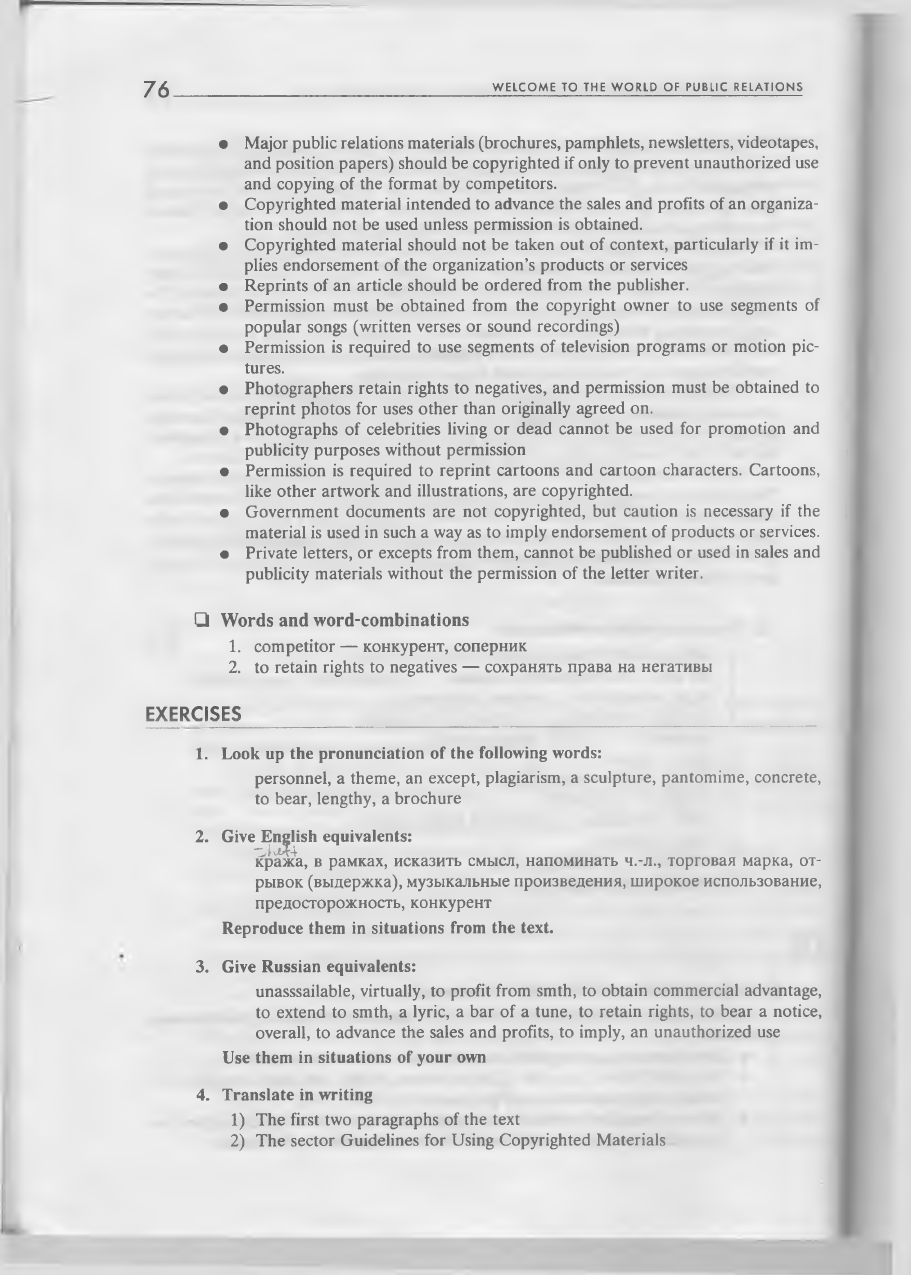
76
W E L C O M E T O T H E W O R L D O F P U B L I C R E L A T I O N S
• Major public relations materials (brochures, pamphlets, newsletters, videotapes,
and position papers) should be copyrighted if only to prevent unauthorized use
and copying of the format by competitors.
• Copyrighted material intended to advance the sales and profits of an organiza
tion should not be used unless permission is obtained.
• Copyrighted material should not be taken out of context, particularly if it im
plies endorsement of the organization’s products or services
• Reprints of an article should be ordered from the publisher.
• Permission must be obtained from the copyright owner to use segments of
popular songs (written verses or sound recordings)
• Permission is required to use segments of television programs or motion pic
tures.
• Photographers retain rights to negatives, and permission must be obtained to
reprint photos for uses other than originally agreed on.
• Photographs of celebrities living or dead cannot be used for promotion and
publicity purposes without permission
• Permission is required to reprint cartoons and cartoon characters. Cartoons,
like other artwork and illustrations, are copyrighted.
• Government documents are not copyrighted, but caution is necessary if the
material is used in such a way as to imply endorsement of products or services.
• Private letters, or excepts from them, cannot be published or used in sales and
publicity materials without the permission of the letter writer.
□ Words and word-combinations
1. competitor — конкурент, соперник
2. to retain rights to negatives — сохранять права на негативы
E X E R C IS E S
1. Look up the pronunciation of the following words:
personnel, a theme, an except, plagiarism, a sculpture, pantomime, concrete,
to bear, lengthy, a brochure
2. Give English equivalents:
"ZsirdJ
:4
кража, в рамках, исказить смысл, напоминать ч.-л., торговая марка, от
рывок (выдержка), музыкальные произведения, широкое использование,
предосторожность, конкурент
Reproduce them in situations from the text.
3. Give Russian equivalents:
unasssailable, virtually, to profit from smth, to obtain commercial advantage,
to extend to smth, a lyric, a bar of a tune, to retain rights, to bear a notice,
overall, to advance the sales and profits, to imply, an unauthorized use
Use them in situations of your own
4. Translate in writing
1) The first two paragraphs of the text
2) The sector Guidelines for Using Copyrighted Materials
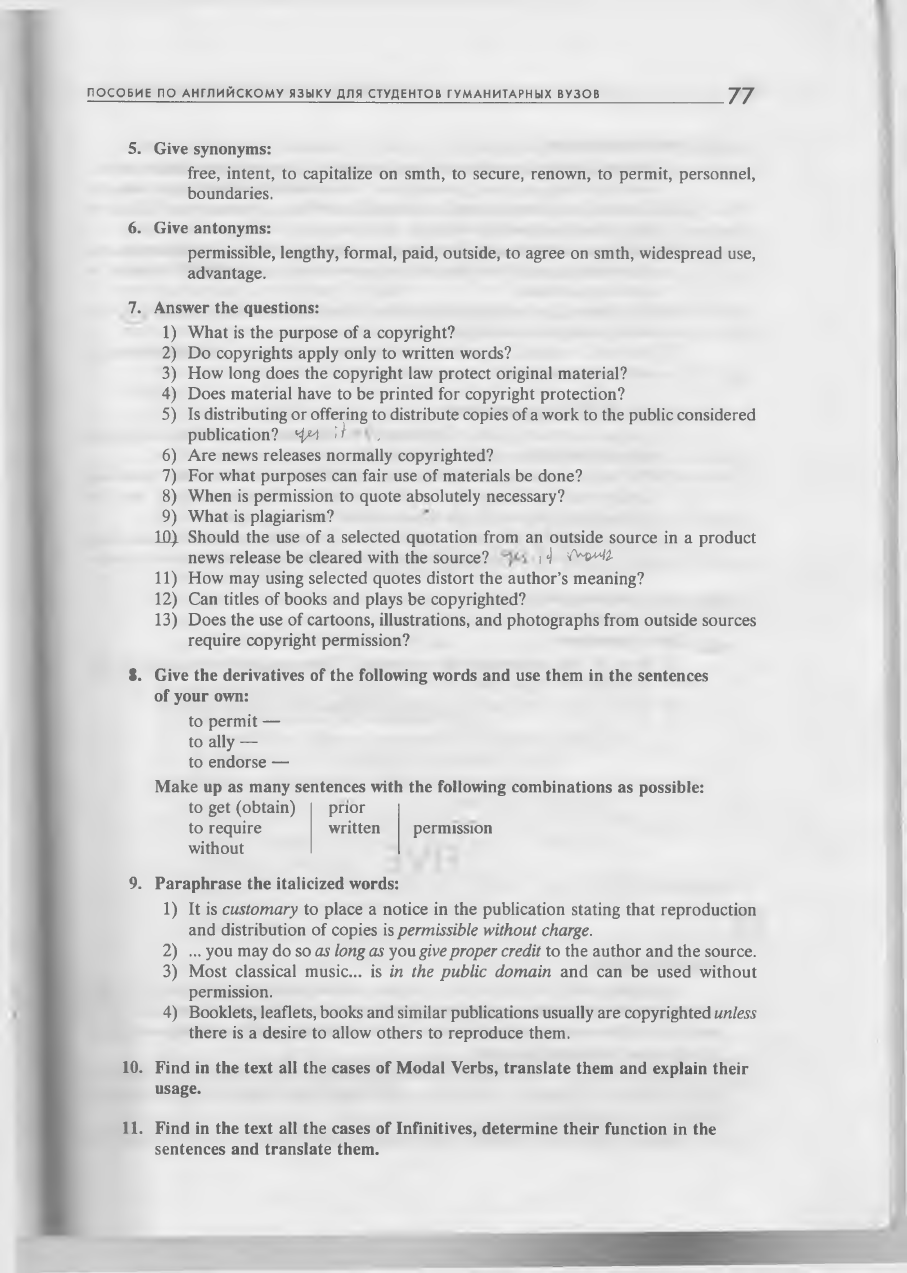
П О С О Б И Е П О А Н Г Л И Й С К О М У Я З Ы К У Д Л Я С Т У Д Е Н Т О В Г У М А Н И Т А Р Н Ы Х В У З О В
77
5. Give synonyms:
free, intent, to capitalize on smth, to secure, renown, to permit, personnel,
boundaries.
6
. Give antonyms:
permissible, lengthy, formal, paid, outside, to agree on smth, widespread use,
advantage.
7.
Answer the questions:
1) What is the purpose of a copyright?
2) Do copyrights apply only to written words?
3) How long does the copyright law protect original material?
4) Does material have to be printed for copyright protection?
5) Is distributing or offering to distribute copies of a work to the public considered
publication?
'iM J
,
6) Are news releases normally copyrighted?
7) For what purposes can fair use of materials be done?
8) When is permission to quote absolutely necessary?
9) What is plagiarism?
10} Should the use of a selected quotation from an outside source in a product
news release be cleared with the source?
i ‘) ^4^2-
11) How may using selected quotes distort the author’s meaning?
12) Can titles of books and plays be copyrighted?
13) Does the use of cartoons, illustrations, and photographs from outside sources
require copyright permission?
S. Give the derivatives of the following words and use them in the sentences
of your own:
to permit —
to ally —
to endorse —
Make up as many sentences with the following combinations as possible:
to get (obtain)
to require
without
prior
written
permission
9. Paraphrase the italicized words:
1) It is
customary
to place a notice in the publication stating that reproduction
and distribution of copies is
permissible without charge.
2) ... you may do so
as long as
you
give proper credit
to the author and the source.
3) Most classical music... is
in the public domain
and can be used without
permission.
4) Booklets, leaflets, books and similar publications usually are copyrighted
unless
there is a desire to allow others to reproduce them.
10. Find in the text all the cases of Modal Verbs, translate them and explain their
usage.
11. Find in the text all the cases of Infinitives, determine their function in the
sentences and translate them.